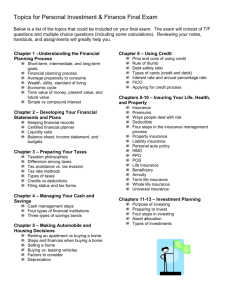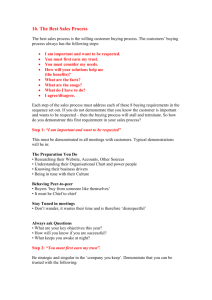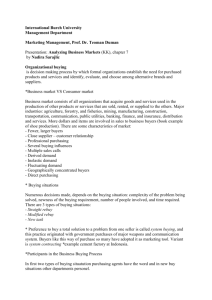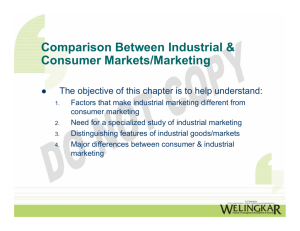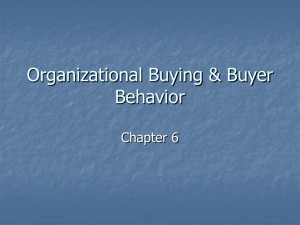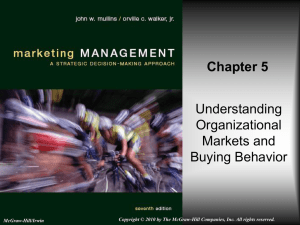Analyzing business markets and business buying behavior
advertisement
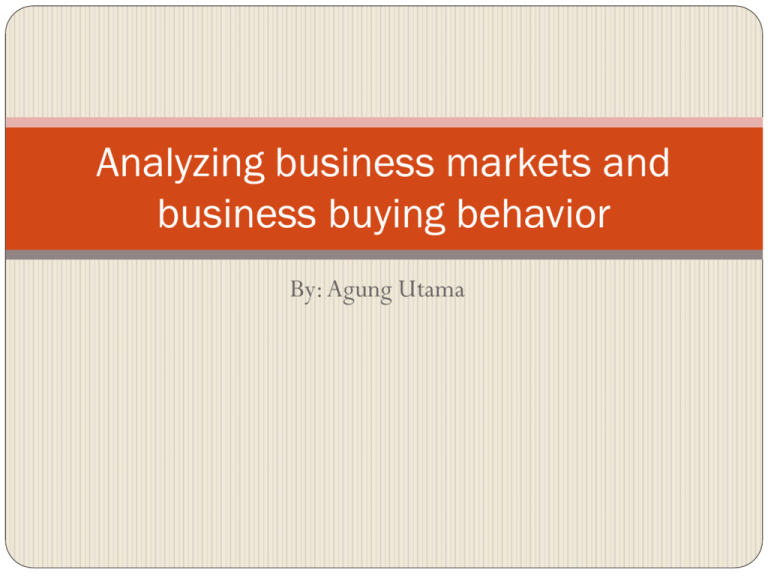
Analyzing business markets and business buying behavior By: Agung Utama What is organizational buying? Organizational buying: decision making process by which formal organizations establish the need for purchased products and services, identify, evaluate, and choose among alternative brands and suppliers. The characteristics of business market • The business market consists of all the organizations that acquire goods and services used in the production of other products or services that are sold, rented, supplied to others. • The major industries making up business markets are: agriculture, transportation, manufacturing, mining, construction, communication, banking, finance, insurance, public utilities, distribution and services. Several characteristics of business markets: Fewer buyer: the business markets normally deals with far fewer buyers than the consumer marketer does. Larger buyer : a few large buyers do most of the purchasing in such industries as aircraft engines and defense weapons. Close supplier-customer relationship : because of the smaller customer base and importance of and the power of the larger customers, supplier are frequently expected to customize their offerings to individual business customer needs. Geographically concentrated buyers: the geographical concentration of producers helps to reduce selling cost. Derived demand : the demand for business goods is ultimately derived from the demand for consumer goods. For this reason, the business marketer must closely monitor the buying patterns of ultimate consumer. In elastic demand : the total demand for many business goods and services is in elastic demand, that is not much affected by price changes. Demand is especially in elastic in the short run because producers can not make quick changes in production methods. Fluctuating demand : the demand for many business goods and services tends to be more volatile than the demand for consumer goods and services. A given percentage increase in consumer demand can lead to a much larger percentage increase in the demand for plant and equipment necessary to produce the additional output. It is called the acceleration effect. Professional purchasing : business goods are purchased by trained purchasing agents, who must follow their organization’s purchasing policies, constraints, and requirements. Several buying influences: more people typically influence business buying decisions. Buying committees consisting of technical experts and even senior management are common in the purchase of major goods. Multiple sale calls: because more people are involved in the selling process, it takes multiple sales calls to win most business order and some sales cycles can take years. Direct purchasing: business buyers often buy directly from manufacturers rather than through intermediaries, especially items that are technically complex or expensive (such as mainframes or aircraft). Reciprocity: business buyers often select suppliers who also buy from them. Leasing: many industrial buyers lease instead of buy heavy equipment like machinery and trucks. The lessee gain a number of advantages: conserving capital, getting the latest products, receiving better services, and gaining some tax advantages. Buying situations • There are three types of buying situations (Patrick Robinson and others): – Straight rebuy: a buying situation in which the purchasing department reorders on a routine basis (eg., office supplies). – Modified rebuy: a buying situation in which the buyer wants to modify product specifications, prices, delivery requirements or other terms. – New task: a buying situation in which purchaser buys a product or service for the first time (eg., office building). The greater the cost or risk, the larger the number of decision participants and the greater their information gathering, and therefore the longer the time to decision completion. Systems buying and selling Many business buyers prefer to buy a total solution to their problem from one seller. Called system buying. This practice originated with government purchases of major weapons and communication systems. Participants in the business buying process Who does the buying of goods and services needed by business organizations? Webster and Wind call the Buying Centre, which consists of all those individuals and groups who participate in the purchasing decisions making process, who share some common goals and the risk arising from the decisions. • Seven roles which playing by the all members in the buying center: – Initiator: those who request that something to be purchased – Users: those who will use the product or service – Influencers: people who influence the buying decisions. – Deciders: people who decide on product requirements or on suppliers. – Approvers: people who authorize the proposed actions of deciders or buyers – Buyers: people who have formal authority to select the supplier and arrange the purchase terms. – Gatekeepers: people who have power to prevent sellers or information from reaching members of the buying centre. For example, purchasing agents, receptionist, and telephone operators may prevent sales persons from contacting users or deciders. Major influences on industrial buying behavior ENVIRONMENTAL •Level of demand •Economic outlook •Interest rate •Rate of technological change •Political and regulatory development •Competitive developments •Social responsibilityu concerns ORGANIZATIONAL •Objectives •Policies •Procedures •Organizational structures •Systems INTERPERSONAL •Interests •Authority •Status •Emphaty •persuasiveness INDIVIDUAL •Age •Income •Education •Job position •Personality •Risk attitudes •culture Business Buyer Environmental factors Business buyers pay close attention to current and expected economic factors: level of production, investment, consumer spending, and the interest rate. In a recession, business reduce their investment in plant, equipment, and inventories. Business buyers actively monitor technological, political regulatory, and competitive developments. Organizational factors Every organization has specific purchasing objectives, policies, procedures, organizational structures and systems. Interpersonal and individual factors Buying centers usually include several participants with differing interest, authority, status, empathy, and persuasiveness. Each buyer caries personal motivations, perceptions, and preferences, which are influenced by the buyers age, income, education, job position, personality, attitudes toward risk, and culture. Cultural factors Here are some rules of social and business etiquette that marketers should understand when doing business in other countries: France: if you do not speak french, apologize for your lack of knowledge. The french are quite proud of their language and believe that everyone should feel privileged to speak it. Germany: Germans are sticklers for titles. Try to introduce people using their full, correct title, no matter how long it is. Japan: Most Japanese businesspeople know what will be discussed at a meeting, how everyone feels about it, and how it will affect their business before they even get there Korea: Korean do not like foreigners to assume that their culture is the same as Japan. Types of Purchasing Process Peter Krajic distinguished four product related purchasing process: 1. 2. 3. 4. Routine product: these product have low value and cost to the customer and involve little risk (office supplies) Leverage product: these products have high value and cost to the customer but involve little risk of supply because many companies make them (engines pistons) Strategic products : these products have high value and cost to the customer, and also involve high risk (main frame computers) Bottleneck products: the products have low value and cost to the customer but they involve some risk (spare parts). The purchasing/procurement process • Stages in the buying process – Problem recognition – General needs description and product specification – Supplier search – Proposal solicitations – Supplier selection – Order routine specification – Performance review

